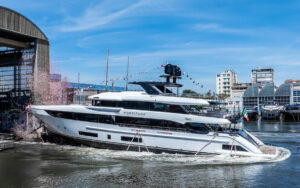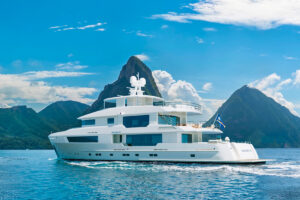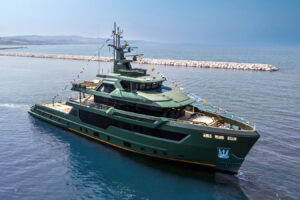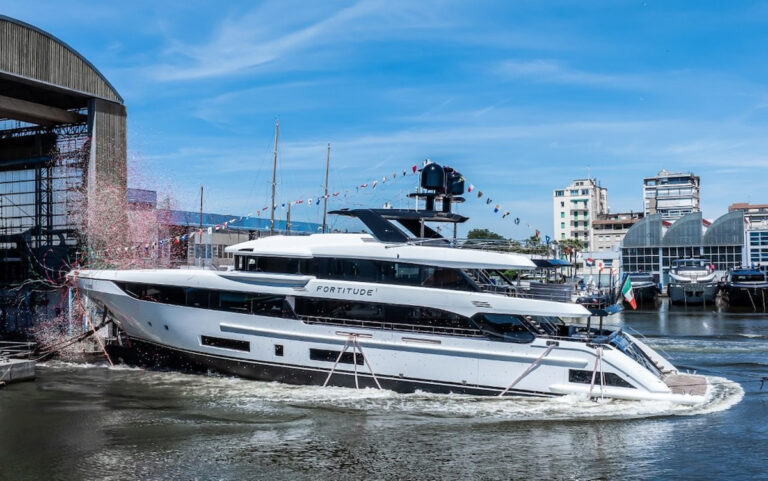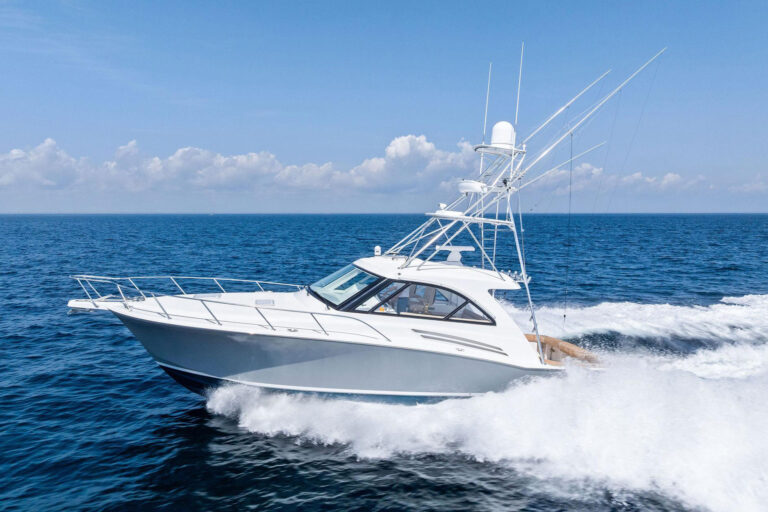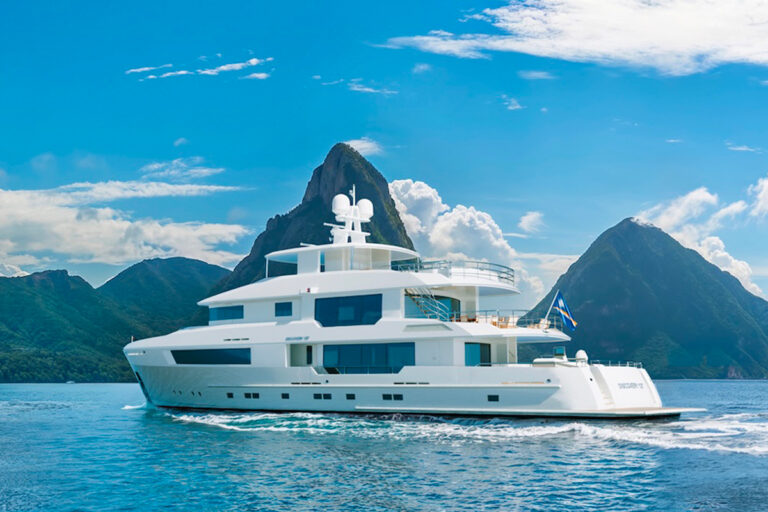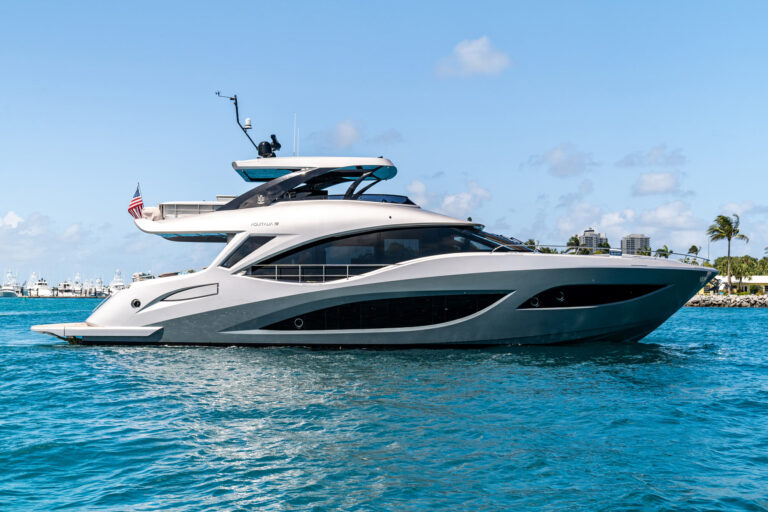
Oyster 72 Sailboat
I am always curious about boat names. Magrathea, the christened name of this Oyster 72, is a fictional planet where the earth was built as a custom project for a wealthy owner. It is from the Douglas Adams book The Hitchhiker’s Guide to the Galaxy. On the boom, the number 42 is prominently displayed, and I discovered that this numeral has a role in the same book. A computer commissioned to work out the meaning of life, the universe and everything else, arrived at the number 42 as the answer after a billion years of calculation. Good to know.
Just as the mainsail was set, Magrathea’s captain, Nick Tolhurst, asked me if I was ready to take the helm. Who would turn down an offer to drive a new Oyster 72? In what seemed like no time at all, the crew had unfurled the headsail and we were under sail. The wind was blowing about 11 knots on a clear fall day off Annapolis, Maryland, and soon we were sailing upwind at 8.2 knots with the apparent wind at 22 degrees (see the complete photo gallery here). I have to admit I love my job.
Like all yachts in the Oyster line, ranging from 46 to 125 feet, the 72 is designed for long-distance passages. In 2010, Tolhurst delivered Magrathea from England to the Caribbean. “With only two crew on board, we stood single-handed watches. It was great,” Tolhurst said. “The boat sails very well. She tracks very straight in waves. You do not corkscrew with the sails trimmed correctly.” I noticed that Magrathea had three reefs in the mainsail, and I asked if he used them often. “Upwind, as soon as we get to about 18 knots of wind, the first reef goes in,” Tolhurst said. “The second is used when the wind is in the mid-20s. She is quite happy with that and a staysail. Over 35 knots, we start looking at using the third reef.”
A Lewmar carbon-fiber wheel on either side of the cockpit allows the helmsman to see around the deckhouse and keep a watch on the headsail’s telltales. The electric winch controls are near the helm for easy trimming. The mainsheet system is self-contained in the boom and is just behind the wheels. There was a full package of Raymarine equipment, including an autopilot, chart plotter, sailing instruments, GPS, VHF and an ST60 Graphic multifunction display at the helm stations.

Although I didn’t get a chance to experience the Oyster 72’s prowess as a sea boat because of the relatively calm conditions on the Chesapeake, we did plow through the confused seas stirred by a flotilla of fairly large motoryachts. Magrathea sailed right through the temporary slop. She didn’t creak or rattle below or on deck. This is one solid boat.
Magrathea’s fully battened mainsail stows within her Park Avenue-style boom. Lazy jacks mind the sail as the crew hoists, reefs or strikes it. Some dedicated cruising sailors prefer an in-boom or in-mast furling system on a boat of this size, but Tolhurst said, “The mast furler is very easy to use, but we prefer the slab-reef system, because we get better performance out of the boat. The boat sails very efficiently with the staysail and main.” The 72 carries a carbon-fiber three-spreader mast, which steps on a hydraulic jack to vary its position fore and aft. Her big spinnaker stows in a Kevlar snuffer sock. “It is one of the better things we bought,” Tolhurst said. “We have had no snags, no twists and no problems. It is our secret weapon for regattas.” The jib and staysail roll up on hydraulic furlers.
The signature design feature of all Oysters is the raised-deck salon. The 72 has an interestingly shaped window on either side that extends across the forward part of the cabin. Down below I found a great view, plenty of light and enough headroom to clear my 6-foot-2-inch height by about three inches. Additional hull ports were added on later versions. We heeled at approximately 15 degrees in the moderate wind, but the many handholds all over the boat made it easy for me to move around safely. The owner’s stateroom has a large double bunk, separate settee, plenty of locker space, television (there were many throughout the boat), full-length mirror and some cool mood lighting. The standard layout includes five staterooms, but Magrathea combines two forward cabins into one with a large double berth for Tolhurst and his significant other.

Tolhurst said they use lithium batteries to keep the boat light. The batteries save about 1,500 pounds. “We charge once per day for about two hours,” he said. Asked if they had any problems with the lithium batteries overheating, he continued, “We haven’t experienced anything like that, but we have pretty good ventilated areas. The original locker was designed for seven normal batteries, so the lithium ones take considerably less space: There is lots of room there.”
The most popular part of this boat will be the cockpit. Ten people will easily fit around the table for dinner. It has a nifty refrigerator that had a full supply of Sam Adams at the ready. This is a good place to hang out, talk, read or watch the sights pass by. Magrathea has a unique Bimini top, which rolls up into the sides of the Park Avenue boom. It’s about seven feet high and is pulled taut to the rails with a 6:1 handy billy system. It is a clever arrangement. Aft, large settees, one in the port quarter and one opposite, can seat a total of four people. I think you could solve the world’s problems right there.
To help owners with the inevitable long list of questions and options, Oyster assigns a personal project manager to assist each one. They are encouraged to visit the factory during construction and be part of the process, which adds to the joy of ownership. When writing a boat review, I always wonder what I might change or do differently. I think the owners of Magrathea did a nice job, right down to a set of hull lights so you can see fish in the water at night, and I wouldn’t make any changes. In any case, Oyster beat me to it and has already updated the design profile since my sea trial. It just keeps getting better.
LOA (including pulpit): 74’9″
LWL: 64’9″
BEAM: 19’2½”
DRAFT: 9’6″ (std.), 7’6″ (shoal option)
DISPL.: 105,820 lb.
SAIL AREA: 3,337 sq. ft. w/ 150 percent foretriangle
SAIL AREA/DISPL.: 23.17
DISPL./LWL: 174
POWER: 1 x 212 hp Cummins QSB5.9
FUEL: 528 gal.
WATER: 264 gal.
BASE PRICE: $4,975,000
Oyster Marine, 401-846-7400; www.oystermarine.com.


